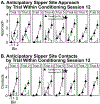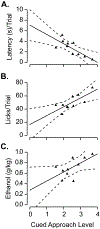Cue-alcohol associative learning in female rats
- PMID: 31002878
- PMCID: PMC6801064
- DOI: 10.1016/j.alcohol.2019.03.003
Cue-alcohol associative learning in female rats
Abstract
The ability of environmental cues to trigger alcohol-seeking behaviors is believed to facilitate problematic alcohol use. We previously showed that the development of this cue-evoked alcohol approach reflects cue-alcohol learning and memory in the adult male rat; however, we do not know whether the same is true for similarly aged female rats. Consequently, adult Long-Evans female rats were allowed to drink unsweetened alcohol in the home cage (Monday, Wednesday, Friday; 24-h two-bottle choice; 5 weeks) and were subsequently split into two experimental groups: Paired and Unpaired. Groups were matched for ingested doses and alcohol bottle preference across the pre-conditioning home cage period. Both groups were trained in conditioning chambers using a Pavlovian procedure. For the Paired group, the chamber houselight was illuminated to signal access to an alcohol sipper. Houselight onset was yoked for the Unpaired group, but access to the alcohol sipper was scheduled to occur only during the intervening periods (in the absence of light). We found that in the Paired, but not Unpaired group, an alcohol approach reaction was conditioned to houselight illumination, and the level of cue-conditioned reactivity predicted drinking behavior within trials. Groups experienced equivalently low but non-negligible blood alcohol concentrations over the course of conditioning sessions. We conclude that cue-triggered alcohol-seeking behavior in adult female rats reflects associative learning about the relationship between alcohol availability and houselight illumination.
Keywords: Cue reactivity; Female rat; Low dose; Oral alcohol; Pavlovian conditioning.
Copyright © 2019 Elsevier Inc. All rights reserved.
Figures





Similar articles
-
Characterizing conditioned reactivity to sequential alcohol-predictive cues in well-trained rats.Alcohol. 2018 Jun;69:41-49. doi: 10.1016/j.alcohol.2017.11.034. Epub 2017 Nov 21. Alcohol. 2018. PMID: 29635111 Free PMC article.
-
Alcohol-associated antecedent stimuli elicit alcohol seeking in non-dependent rats and may activate the insula.Alcohol. 2019 May;76:91-102. doi: 10.1016/j.alcohol.2018.08.004. Epub 2018 Aug 17. Alcohol. 2019. PMID: 30612041 Free PMC article.
-
Nicotine-induced enhancement of Pavlovian alcohol-seeking behavior in rats.Psychopharmacology (Berl). 2017 Feb;234(4):727-738. doi: 10.1007/s00213-016-4508-2. Epub 2016 Dec 23. Psychopharmacology (Berl). 2017. PMID: 28011981
-
Pavlovian-conditioned alcohol-seeking behavior in rats is invigorated by the interaction between discrete and contextual alcohol cues: implications for relapse.Brain Behav. 2014 Mar;4(2):278-89. doi: 10.1002/brb3.216. Epub 2014 Feb 6. Brain Behav. 2014. PMID: 24683519 Free PMC article.
-
Alcohol-seeking and relapse: A focus on incentive salience and contextual conditioning.Behav Processes. 2017 Aug;141(Pt 1):26-32. doi: 10.1016/j.beproc.2017.04.019. Epub 2017 May 1. Behav Processes. 2017. PMID: 28473252 Review.
Cited by
-
Evidence for incentive salience sensitization as a pathway to alcohol use disorder.Neurosci Biobehav Rev. 2019 Dec;107:897-926. doi: 10.1016/j.neubiorev.2019.10.009. Epub 2019 Oct 28. Neurosci Biobehav Rev. 2019. PMID: 31672617 Free PMC article. Review.
-
Learning processes in relapse to alcohol use: lessons from animal models.Psychopharmacology (Berl). 2023 Mar;240(3):393-416. doi: 10.1007/s00213-022-06254-x. Epub 2022 Oct 20. Psychopharmacology (Berl). 2023. PMID: 36264342 Review.
-
Friend recollections, and a collection of collaborations with Nadia.Front Behav Neurosci. 2022 Jul 29;16:954906. doi: 10.3389/fnbeh.2022.954906. eCollection 2022. Front Behav Neurosci. 2022. PMID: 35967900 Free PMC article. Review.
-
Operant ethanol self-administration behaviors do not predict sex differences in continuous access home cage drinking.Alcohol. 2025 Mar;123:87-99. doi: 10.1016/j.alcohol.2024.08.004. Epub 2024 Aug 31. Alcohol. 2025. PMID: 39218047
-
Sex Differences in the Neurobiology of Alcohol Use Disorder.Alcohol Res. 2020 Oct 8;40(2):04. doi: 10.35946/arcr.v40.2.04. eCollection 2020. Alcohol Res. 2020. PMID: 33042719 Free PMC article. Review.
References
-
- Bertholomey ML, Nagarajan V, & Torregrossa MM (2016). Sex differences in reinstatement of alcohol seeking in response to cues and yohimbine in rats with and without a history of adolescent corticosterone exposure. Psychopharmacology, 233(12), 2277–2287. 10.1007/s00213-016-4278-x - DOI - PMC - PubMed
Publication types
MeSH terms
Substances
Grants and funding
LinkOut - more resources
Full Text Sources

